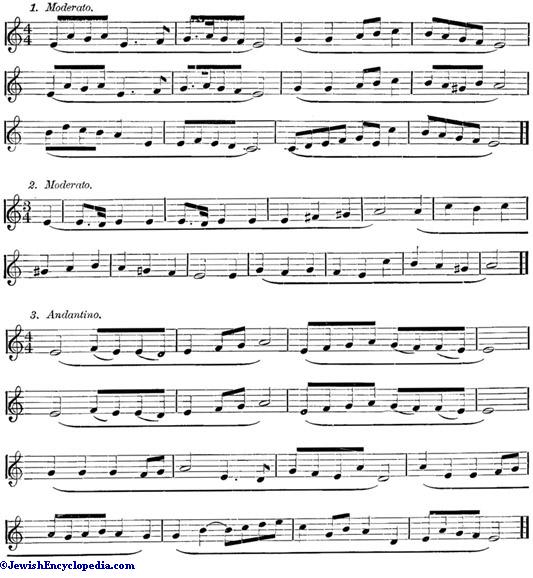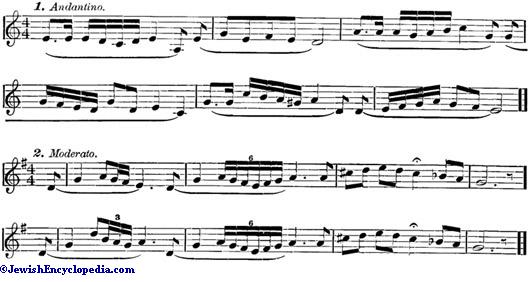ḲEROBOT (lit. "prayers of approach," i.e., to God"; comp. Jer. xii. 2; Yer. Ber. 8b: "bo we-ḳareb"; Lev. R. xxx.: "ḳarob u-payyeṭan"; comp. Jastrow, "Dict." cols. 1410 and 1413):
A term applied to the scheme of
The living tradition evidences a well-grounded stability, as might have been expected from the authority attached to MaHaRIL's liturgical decisions by the standard code of the Shulḥan 'Aruk (see Moses Isserles on Oraḥ Ḥayyim, 619, 1). The traditional melodies for the Ḳerobot, indeed, are distinguished from all other strains associated with piyyuṭim in that while the latter are usually derived from the folk-song of late medieval or modern Europe, the former have a more ancient character of their own. This distinction was already noted by Simeon b. Ẓemaḥ Duran ("Magen Abot," p. 52b) about the year 1400. The melodies, too, which are named in the rubric to so many hymns in the older liturgies (comp. Zunz, "S. P." p. 116) refer more often to verses in the Ḳerobot than to any others.
"Reshut."The scheme of the Ḳerobot always opens with a "reshut," or prayer of the cantor for divine guidance and an expression of consciousness on his part that he is unworthy of fulfilling his task. The strain in which the reshut is intoned runs through the whole Ḳerobah, reappearing in the final verselets of each poem, which, since the printing of the Maḥzor placed copies of the text in the hands of ordinary congregants, have alone been chanted at length, the body of the piyyuṭ being read through in an undertone. Such silently read verses form the main succeeding portion of the Ḳerobot, but were originally chanted at length. Some older tunes, quoted as models for later introductions, were lost when the excessive length of the cantor's chanting led to complaints and to the omission of the time-absorbing singing (Güdemann, "Quellenschriften zur Gesch. des Unterrichts und der Erziehung bei den Deutschen Juden," pp. 85, 105, 118, 300).
Versicle Themes.The strain for the reshut and the versicles following it is, whether festival or penitential, a melody of definite character and antique tonality. The festival form is obviously based on the Oriental chromatic scale (Bourgault-Ducoudray, "Melodies Populaires de Grèce et d'Orient," p. 21) in which the Sabbath service (Ḥazzanut) is chanted, a prayer-motive utilized on the festivals as well. The versicle theme for New-Year and Atonement is not so closely allied to the ḥazzanut of the day, which is in the third mode ("E" to "e") of the Catholic plain-song; for it falls in the first church mode ("D" to "d" in the natural scale). But this last was the favorite scale-form for melody generally in northern Europe during the early Middle Ages, from which the strain obviously dates. It will be noticed in the accompanying example how much beauty is added by the accidental, which the church musicians, who deemed this mode adapted to "grave, majestic, and sublime" subjects, would not have permitted, even as a grace-note.





Versicles founded on Ps. cxlvi. 10 and xxii. 4 lead to the next division of the Ḳerobot scheme, which is pervaded by verse-forms due to Eleazar Ḳalir (c. 800), and presents, from internal evidence, some of the antique melody which Duran (l.c.) attributed to him. The section is ushered in by a short group of triplets concluding with the word  . These are followed by acrostic strophic hymns written by Ḳalir or his imitators, in which, on the penitential days, after the rime scheme, "a a a, b b b, c c c" (the italicized member being recited by the congregants in response to the two members chanted by the officiant), the triplet ending in "ḳadosh" is introduced as a refrain. For all such hymns, and others from the same sources chanted at this point in the Ashkenazic liturgy, there are utilized traditional melodies which, although divergent in a number of variants, bear traces of a common early medieval origin, and of a primal tonality agreeing with the third mode of the Catholic plain-song ("E" to "e" in the natural scale), with the semitones characteristically falling between the first and second and between the fifth and sixth degrees. This quaint archaic scale-form ("tertius mysticus") is that in which the prayers for the penitential mornings are, in the northern tradition, likewise cast.
. These are followed by acrostic strophic hymns written by Ḳalir or his imitators, in which, on the penitential days, after the rime scheme, "a a a, b b b, c c c" (the italicized member being recited by the congregants in response to the two members chanted by the officiant), the triplet ending in "ḳadosh" is introduced as a refrain. For all such hymns, and others from the same sources chanted at this point in the Ashkenazic liturgy, there are utilized traditional melodies which, although divergent in a number of variants, bear traces of a common early medieval origin, and of a primal tonality agreeing with the third mode of the Catholic plain-song ("E" to "e" in the natural scale), with the semitones characteristically falling between the first and second and between the fifth and sixth degrees. This quaint archaic scale-form ("tertius mysticus") is that in which the prayers for the penitential mornings are, in the northern tradition, likewise cast.
The original model tune was most probably due to one of the earliest writers of synagogal hymnody, who, like ḳalir himself, composed and recited both verses and melody, and handed them on to distant congregations by means of their ever-wandering pupils (Zunz, "Ritus," pp. 7 et seq.). In one form it was particularly widely quoted in old ritual manuscripts as an inherited air to be utilized also for other poems (Zunz, "S. P." p. 115; Dukes, in "Orient, Lit." iv. 540), the rubric  ("to the tune of A'apid,'" which happens to be among the first of this class of piyyuṭim met with as the liturgy is gone through) being one of the most frequent of such superscriptions. Another variant of the melody is known and prized in the Reform liturgy. It is the original of the tune for the hymn "To Thee We Give Ourselves To-Day," No. 103 in the American "Union Hymnal."
("to the tune of A'apid,'" which happens to be among the first of this class of piyyuṭim met with as the liturgy is gone through) being one of the most frequent of such superscriptions. Another variant of the melody is known and prized in the Reform liturgy. It is the original of the tune for the hymn "To Thee We Give Ourselves To-Day," No. 103 in the American "Union Hymnal."
But these original melodies, whose identity is plain under all their modern variations, are not the only melodies which have been followed in the chant for the refrain triplets ending in "ḳadosh," since Polish cantors often utilize a later but not less effective secondary theme, recalling Levantine tonality as the other also does.
The Ḳerobot finally come to an end in a long meditation ushering in the Ḳedushshah, which is aptly entitled the "Silluḳ" (= "conclusion" or "cessation," i.e., of the singing).
- The chants are assembled in Baer, Ba'al Tefillah, Nos. 650-660, 1057-1107, et passim, Göteborg, 1887, Frankfort, 1883. The two forms of the refrain triplet are contrastingly arranged in The Voice of Prayer and Praise, Nos. 202 and 203, by F. L. Cohen and D. M. Davis, London, 1889. For the variants of the antique hymn-tune see especially Baer, l.c. Nos. 1099, 1102, and 1274;
- Marksohn and Wolf, Synagogal-Melodien, No. 12, Leipsic, 1875;
- Pauer and Cohen, Traditional Hebrew Melodies, No. 17, London, 1897.



